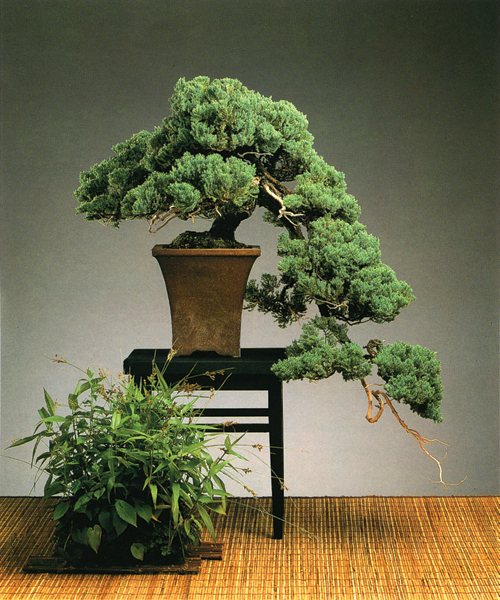
Shore Juniper (J. procumbens) by master bonsai innovator, Masahiko Kimura. I like this one. It combines the sculptural look that has been favored by some Japanese bonsai artists (especially in the 90s) with a more wild, rugged natural look that is in favor in much of the world bonsai community. Not that bonsai is so simple that it can be divided into two categories; sculptural versus natural. If bonsai is an art, then categories are continually being broken down as artist play, explore and innovate. And no bonsai artist that I know of, has played, explored and innovated more successfully that Master Kimura. Photo is from our Juniper book.
What is it about junipers?
Junipers are tough, durable, flexible (they take to wire like they were made for it) and pruneable. They don’t mind having their roots hacked (sometime quite heavily) and they take to container culture. Their needles tend to be small and dense and both their needles and bark come in a range of attractive (sometimes luminous) colors and textures. Perhaps best of all, junipers take to carving like few other plants; and their deadwood is both attractive and long lasting (all deadwood eventually rots, but juniper wood rots more slowly than most), especially if you keep it clean and apply lime sulfur.
Everywhere and for everyone
Junipers grow almost everywhere in the northern hemisphere (they don’t occur south of the equator), from the Arctic tundra to the Central American mountains and African tropics. This means that there are varieties for almost any climate, including some that can survive indoors (only under just the right conditions, with the emphasis on survive, rather than on grow; as indoor cultivation is tough on most plants – but that’s a story for another time). All this makes junipers a first choice for bonsai, from beginners all the way to the masters.

Dwarf Japanese garden juniper (J. procumbens ‘Nana’). By Jerald B. Stowell. From Bonsai Today issue 26. Procumbens nana is by far the most popular juniper for beginners, at least here in the States (it’s the one you see ad nauseam in the malls around the Holidays). However, you seldom see a masterpiece, as the trunks tend to stay too thin. The trunk on this one is about a thick as they ever get.